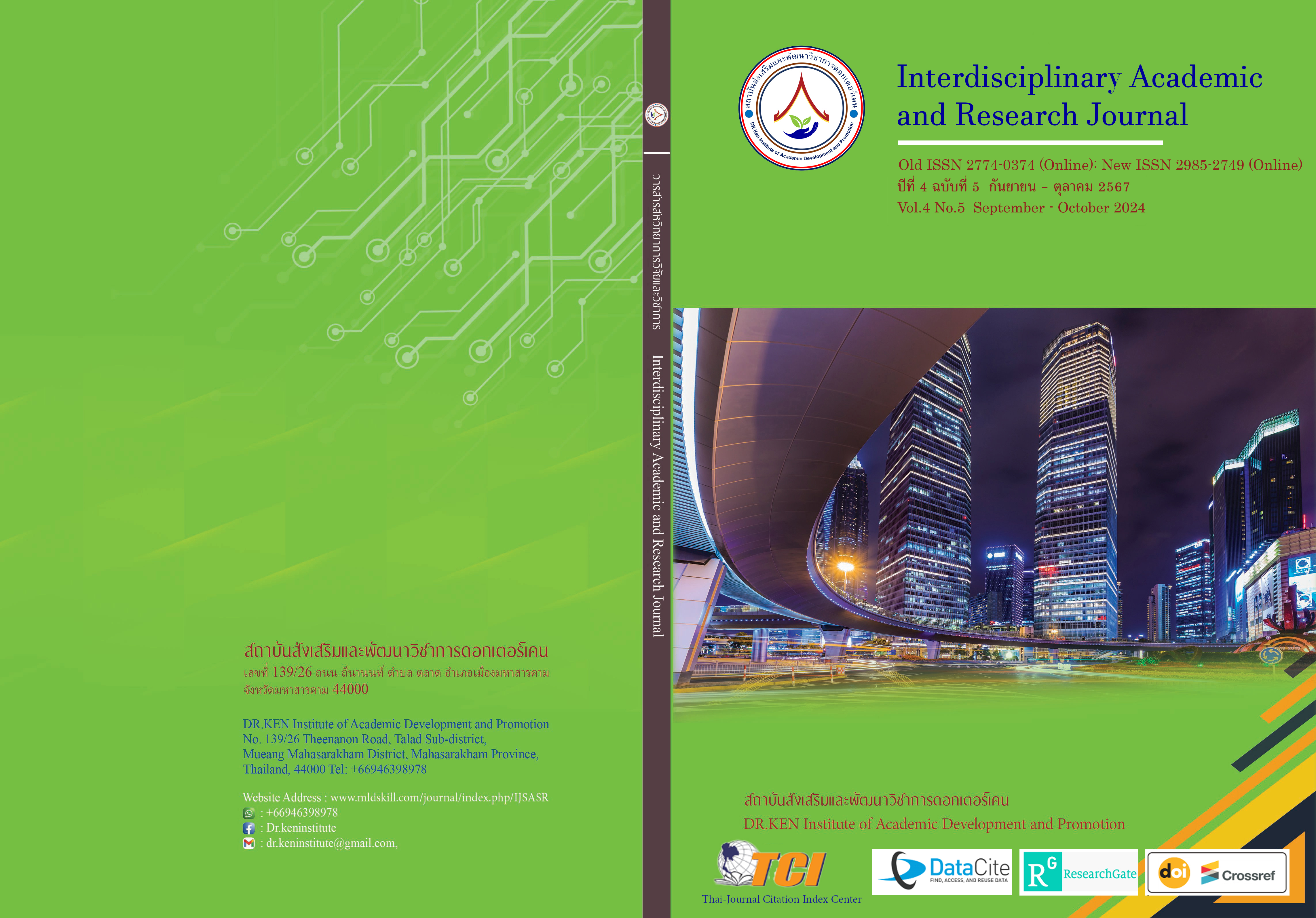Success Mechanisms and Factors Affecting Rehabilitation of Drug Addicts with Community Participation: A Case Study in Chaiyaphum Province
DOI:
https://doi.org/10.60027/iarj.2024.277386Keywords:
Community Participation; , Drug RehabilitationAbstract
Background and Aims: The country is impacted by the drug problem in many ways. Impact on the nation's reputation and security. influence on the management of public affairs. The idea that drug users and addicts are seen as "patients" is a human nature that legal policies aimed at solving the drug problem start to take into consideration. This research aims to (1) study the mechanisms for rehabilitation of drug addicts in Thailand. (2) study factors affecting the success of drug addiction rehabilitation with community participation.
Methodology: The researcher used document review (Documentary Research) with in-depth interviews to process the process of community-based drug addiction rehabilitation. and use the analytical hierarchy process (AHP) to study factors affecting success.
Results: The results of the study found that (1) The mechanism of success in the rehabilitation process for drug addicts involves community participation. This arises from the role of the community as an important factor. There must be a common opinion that this is an important problem that should be solved. Coordinate with various agencies involved to help with screening Evaluate and diagnose problems to receive rehabilitation treatment. and following up with social assistance after rehabilitation There is a drive for drug work in the community. Meet to discuss and follow up on work regularly. To find a solution to the problem. (2) Factors that contribute to the success of rehabilitation in the community. There are a total of 8 factors. Results from the stepwise analysis study found that the role of support from the community is a factor. The highest priority is 17 percent because support from the community will be a very important part that provides opportunities for relevant agencies, including government agencies, the private sector, and civil society networks. Participate in acknowledging problems and creating solutions to problems together. Followed by: Factors involved in the treatment process (16 percent), support mechanism factors for each sector (15 percent), government policy support factors (13 percent), drug addiction rehabilitation process factors (11 percent), legal factors Drug-related factors (10 percent), success indicators (9 percent) and implementation time factors (9 percent)
Conclusion: The study concludes that community involvement is critical to the success of drug rehabilitation, emphasizing the need for regular follow-up sessions and coordinated efforts between various agencies. Important success factors include community support (17%), treatment process participation (16%), and industry support networks (15%).
References
ฉัตรวรัญ องคสิงห์. (2559). วาทกรรมยาเสพติด: อิสรภาพของผู้ต้องขังหญิง Discourse on Drugs: Freedom of Female Prisoners. การประชุมวิชาการระดับชาติ มหาวิทยาลัยรังสิต ประจำปี 2559 (RSU National Research Conference 2016)
ชฎากาญจน์ ชาลีรัตน์. (2565). การพัฒนารูปแบบการบำบัดรักษาฟื้นฟูด้วยแนวคิดการเรียนรู้จากประสบการณ์ และพลังภาคีเครือข่ายสำหรับผู้เสพยาเสพติดระบบสมัครใจในจังหวัดสระบุรี. วารสารสาธารณสุขและสุขภาพศึกษา. 2 (1), 49-68.
ณฐพร ผลงาม.(2564). การพัฒนารูปแบบการบำบัดฟื้นฟูสมรรถภาพผู้ป่วยยาเสพติด โดยการมีส่วนร่วมของชุมชนจังหวัดระยอง.วารสารศาสตร์สาธารณสุขและนวัตกรรม. 1 (2), 49-71.
นิตยา ฤทธิ์ศรี, สุกัญญา วัฒนประไพจิตร, ศุภลักษณ์ จันหาญ(2565). รูปแบบการบำบัดรักษาและฟื้นฟูผู้ใช้ยาเสพติดโดยชุมชุมเป็นศูนย์กลาง : กรณีศึกษาในหมู่บ้านแห่งหนึ่ง อำเภอเมืองมหาสารคาม จังหวัดมหาสารคาม. วารสารโรงพยาบาลมหาสารคาม. 19 (2), 50-62.
ประจวบ แหลมหลัก, พิชญะ เดชโชติวิรุฬห์, ประภาพร คําเหมือง, นิภรดา ยาวิราช, จีรวรรณ ยศแผ่น, ธนกมล สีหมากสุก. (2557). ปัญหายาเสพติดในสังคมไทยมุมมองทางสังคมวิทยา. วารสารการพยาบาล การสาธารณสุข และการศึกษา วิทยาลัยพยาบาลบรมราชนนี พะเยา, 15(3), 3-13.
มานพ คณะโต. (2551). โครงการศึกษาสถานการณ์และการแก้ไขปัญหายาเสพติดในสถานศึกษาภาคตะวันออกเฉียงเหนือ. ขอนแก่น: เครือข่ายพัฒนาวิชาการและข้อมูลสารเสพติดภาคตะวันออกเฉียงเหนือ มหาวิทยาลัยขอนแก่น.
วนิตตา พิทยาเรืองนนท์ และอารณีย์ วิวัฒนาภรณ์. (2565). ปัญหาในการบำบัดรักษาผู้ติดยาเสพติด กรณีศึกษาในสถานพยาบาลของรัฐ. วารสารวิจัยธรรมศึกษา. 5 (2), 94-102.
วิษณุ คำโนนม่วง. (2558). มาตรการทางกฎหมายในการบำบัดฟื้นฟูผู้ติดยาเสพติด : ศึกษากรณีการนําระบบสมัครใจบำบัดมาใช้ฟื้นฟูสมรรถภาพผู้ติดยาเสพติด. ปริญญานิติศาสตรมหาบัณฑิต สาขากฎหมายอาญา คณะนิติศาสตร มหาวิทยาลัยธรรมศาสตร์.
ศิระ บุญแทน. (2561).การนำนโยบายป้องกันและปราบปรามยาเสพติดไปปฏิบัติ: กรณีศึกษาพื้นที่อำเภอกำแพงแสน จังหวัดนครปฐม. วิทยานิพนธ์ (ศศ.ม. (การเมืองและยุทธศาสตร์การพัฒนา): สถาบันบัณฑิตพัฒนบริหารศาสตร์.
อับดุลคอลิก อัรรอฮีมีย์ และคณะ. (2564). รูปแบบการป้องกันตนเองในการใช้สารเสพติดซ้ำของผู้ติดสารเสพติดในพื้นที่จังหวัดปัตตานี กรณีศึกษา ผู้เข้ารับการบำบัดรักษายาเสพติดในศูนย์บำบัด บ้านแสนสุข และสถาบันปอเนาะพัฒนาเยาวชน. รายงานวิจัยฉบับสมบูรณ์ ศูนย์ศึกษาปัญหายาเสพติด (ศศก.).
Laguna, E.H., Sanchez-Toribio, M.I., Diaz, L.R., & Leon, A. (1999). Multiple Criteria Decision Making (MCDM), applied to the Modernization Plan of the Traditional Irrigation of Mula, Spain’. ICID Journal, 48 (3), 47-58
Nakkam, I. (2023). Treatment and rehabilitation of drug addicts to society. The National Defence College of Thailand Journal. 65 (2), 97-105.
Saaty, T.L. (2008) Decision Making with the Analytic Hierarchy Process. International Journal of Services Sciences, 1, 83.
https://doi.org/10.1504/IJSSCI.2008.017590
Sareelae, N. (2018). Factors affecting intention to stop substance abuse among users addicted treatment at Thanyarak UdonthaniHospital. Nursing, Health, and Education Journal. 1 (3), 35-42.
Thai PBS. (2566). สถานการณ์ยาเสพติด 2566 แนวรบไม่เคยเปลี่ยน. Retrieved from: https://www.thaipbs.or.th/news/content/328947
UNGASS. (2016). OUR JOINT COMMITMENT TO EFFECTIVELY ADDRESSING AND COUNTERING THE WORLD DRUG PROBLEM. Thirtieth Special Session General Assembly New York
United Nations Office on Drugs and Crimes, (2010). Community-Based Treatment and Care for Drug Use and Dependence. Retrieved from: https://www.unodc.org/roseap/uploads/archive/documents/ cbtx/cbtx_brief_EN.pdf
UNODC. (2008). TREATMENT – Drug Dependence Treatment: Sustained Recovery Management. Good Practice Document. Retrieved from: http://www.unodc.org/docs/treatment/111SUSTAINED_RECOVERY_MANAGEMENT.pdf.
World Drug Report. (2022). World Drug Report 2022. Retrieved February 15, 2024. www.phufaresthome.com/blog/world-drug-report-2022-summary/
Downloads
Published
How to Cite
Issue
Section
License
Copyright (c) 2024 Interdisciplinary Academic and Research Journal

This work is licensed under a Creative Commons Attribution-NonCommercial-NoDerivatives 4.0 International License.
Copyright on any article in the Interdisciplinary Academic and Research Journal is retained by the author(s) under the under the Creative Commons Attribution-NonCommercial-NoDerivatives 4.0 International License. Permission to use text, content, images, etc. of publication. Any user to read, download, copy, distribute, print, search, or link to the full texts of articles, crawl them for indexing, pass them as data to software, or use them for any other lawful purpose. But do not use it for commercial use or with the intent to benefit any business.
















.png)


